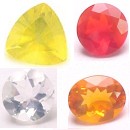|
Click on a letter above to view the list of gems. |
|
|
|
|
|
|
|
|
Opal:
Brazil
and Mexico |
|
| Chemistry: SiO2 + 5-10% nH2O | |
| Prehistoric
Discovery;
IMA
status: Valid (pre-IMA; Grandfathered). | ||
|
| ||
|
Classification |
|
|
| |
|
Oxides | |
|
|
4 : Oxides & Hydroxides |
|
|
|
|
Crystal Data |
|
|
|
|
|
Amorphous (no crystalline forms) |
|
|
Amorphous - (no crystalline forms) Habits include Massive; Concretions; Botryoidal; Stalactitic; Reniform - "kidney like" in shape (e.g. Hematite); cavity fillings (e.g. in fractures and geodes); replacement of other minerals or wood. |
|
|
|
|
|
Physical Properties |
|
|
|
|
|
None (amorphous) |
|
|
Conchoidal |
|
|
Brittle |
|
|
5.5 - 6.0 |
|
|
1.90 - 2.30 (g/cm3) |
|
|
Not Radioactive |
|
|
|
|
|
Optical Properties |
|
|
|
|
|
Colorless, white, yellow, orange, red, yellowish brown, greenish, blue, gray, black, violet. |
|
|
Transparent to Translucent to Opaque |
|
|
Vitreous, Waxy, Pearly, Dull |
|
|
1.43 Isotropic |
|
|
0.00 (Isotropic) |
|
|
Weak |
|
|
Distinct; red, orange, yellow, green, blue |
|
|
|
|
|
Occurances |
|
|
|
|
|
Geological Setting: |
Sedimentary and secondary from the alteration of high silica igneous extrusive rocks. |
|
Type Locality: |
n/a |
|
Year Discovered: |
Prehistoric discovery |
|
View mineral photos: | |
|
|
|
|
More Information |
|
|
|
|
|
| |
|
|
|
|
|
|
|
|
